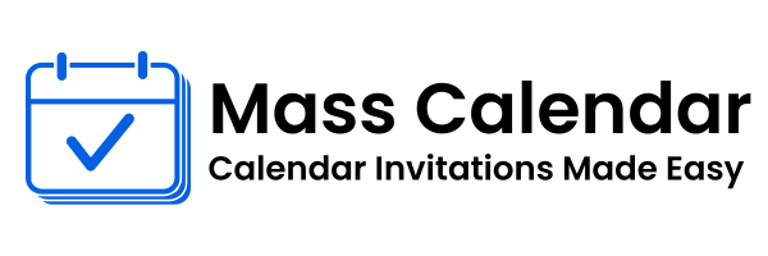AddEvent Alternative: Exploring Options for Scalable Calendar Invites
In today’s digital-first landscape, sending calendar invitations to large groups has become more than just a convenience—it’s a necessity for efficient event coordination. Tools like AddEvent and Let’s Calendar offer solutions for streamlining how meetings, webinars, and conferences are scheduled and added to attendee calendars.
BLOG
5/26/20254 min read


In today’s digital-first landscape, sending calendar invitations to large groups has become more than just a convenience—it’s a necessity for efficient event coordination. Tools like AddEvent and Let’s Calendar offer solutions for streamlining how meetings, webinars, and conferences are scheduled and added to attendee calendars.
While AddEvent is known for its simple calendar embed options and add to calendar widgets, Let’s Calendar provides broader functionality tailored for high-volume scheduling, such as bulk invite management, real-time RSVP tracking, and automation features. Both tools serve specific use cases, and the right choice depends on the needs of the organization or individual.
This article explores the key differences between these two tools, breaks down their feature sets, and introduces factors to consider when selecting a calendar scheduling platform.
🔍 Why Calendar Invite Tools Matter
For teams managing recurring meetings, public events, or high-volume attendee lists, manually coordinating schedules is inefficient and error-prone. Calendar invitation tools help standardize the process across platforms like Google Calendar, Outlook, and Apple Calendar—especially when dealing with .ics file structures or formatting compatibility across devices.
A reliable calendar tool should support:
Multi-calendar compatibility
Easy integration with event platforms (Zoom, Google Meet, etc.)
Personalized or group-based scheduling
Automation of follow-ups and cancellations
Analytics and tracking for engagement
Let’s explore how AddEvent and Let’s Calendar approach these challenges.
🧩 AddEvent vs. Let’s Calendar: Key Differences
When comparing AddEvent and Let’s Calendar, both tools help users share events and calendar invites, but they serve different needs — especially when it comes to scale and functionality. Here’s a breakdown of the key differences:
Primary Use:
AddEvent is mainly used for adding "Add to Calendar" buttons and embedding calendars into websites. Let’s Calendar, on the other hand, is built for sending bulk calendar invites at scale and managing entire invite campaigns efficiently.Invite Volume:
AddEvent supports a limited number of contacts for event invitations, making it suitable for smaller groups. Let’s Calendar supports unlimited contacts, making it ideal for large-scale events, webinars, or conferences.Calendar Button/Widget Support:
Both tools allow users to create "Add to Calendar" buttons and widgets for websites and landing pages..ics File Support:
Both platforms support .ics calendar files, but Let’s Calendar offers customizable formats, allowing more personalization and control over the calendar experience.RSVP Tracking:
AddEvent provides basic RSVP tracking, while Let’s Calendar features advanced acceptance reporting, giving organizers deeper insights into attendee engagement.Campaign Management:
AddEvent does not include built-in campaign features. In contrast, Let’s Calendar allows users to create unlimited campaigns, helping teams manage multiple events or meeting series more easily.Zoom and Other Tool Integrations:
AddEvent offers minimal integration options. Let’s Calendar provides native integration with Zoom and supports thousands of other tools via Zapier, simplifying workflows and automation.Event Cancellation Handling:
With AddEvent, cancellations must be handled manually. Let’s Calendar provides automated calendar updates, ensuring attendees always have the latest information.Sub-User or Team Access:
AddEvent is a single-user tool. Let’s Calendar supports team-based access and sub-user roles, which is critical for organizations managing events collaboratively.
Both platforms offer basic tools to add events to calendar, but Let’s Calendar adds support for recurring scheduling, CSV-based bulk uploads, and automated event cancelled handling—features useful for larger teams or event marketing operations.
🧠 Considerations When Choosing a Tool
Here are some considerations that help identify the right platform for different needs:
1. Volume and Scale
If your organization needs to send invites to thousands of attendees regularly, tools like Let’s Calendar that support bulk uploads and campaigns may be more effective. AddEvent works well for smaller teams embedding one-time calendar buttons.
2. Automation
If you’re integrating calendar workflows with form submissions, CRM actions, or webinar registrations, support for Zapier or direct integrations with platforms like Zoom can save time and reduce manual coordination.
3. Data and RSVP Tracking
Tracking who has accepted, declined, or opened an invite is critical for attendance forecasting. Let’s Calendar includes downloadable acceptance reports, while AddEvent provides more basic engagement metrics.
4. Cancellation and Updates
Automating follow-ups or resending invites in case an event is cancelled can reduce confusion. Platforms that automatically push updates to attendee calendars help ensure up-to-date information.
5. Team Collaboration
For organizations managing multiple events or internal departments, sub-user permissions can help manage who edits what—something supported in Let’s Calendar.
⚙️ Key Features to Look For
When evaluating any add event calendar tool or looking for an addevent alternative, consider the following features based on your scheduling needs:
Support for all major calendars (Google, Outlook, Apple)
Ease of embedding addtoevent buttons into websites or emails
Bulk invite capabilities via CSV or integrations
Ability to format ICS files based on organizational standards
RSVP tracking and download options
Automated resending or event cancellation notifications
Integration with webinar platforms (e.g., Zoom)
Cross-platform compatibility for recipients across devices
For example, if you’ve ever looked up how to add event to Google Calendar manually for multiple attendees, tools like Let’s Calendar can automate that process at scale while preserving the correct ics file structure and ensuring compatibility with platforms like Google Calendar with weather or Outlook.
☁️ How Google Calendar Handles Events and Weather
Tools like Google Calendar often integrate external features such as local weather data or travel time. If you’re planning events in different cities, being aware of how weather calendar for Google Calendar works can be helpful—especially if you expect attendees to travel or need to consider timing.
Regardless of the tool used—AddEvent or Let’s Calendar—well-structured invites are displayed consistently in services like Google Calendar weather, especially when using valid format ics file parameters.
🔚 Conclusion: Match the Tool to the Task
Both AddEvent and Let’s Calendar offer value, but they’re built for different use cases.
AddEvent is suited for lighter workflows—like embedding calendar buttons or managing small-scale event reminders.
Let’s Calendar is tailored for high-volume, campaign-based scheduling and event lifecycle management.
If your needs are simple—such as embedding a clean “add event” button—AddEvent may be sufficient. But if your workflow includes CSV uploads, recurring sessions, acceptance tracking, or integrations with Zoom and CRM tools, a more full-featured tool may be warranted.
As always, evaluating based on scale, automation needs, and collaboration workflows will help you make the best decision—whether you're creating an ad event for a small meetup or managing an enterprise-level add event to calendar campaign.
MassCalendar.in
Send Bulk & Mass Calendar Invites Instantly
CONTACT
Meetings
+44 (0) 203 916 5117
© 2025. All rights reserved.
Help?
